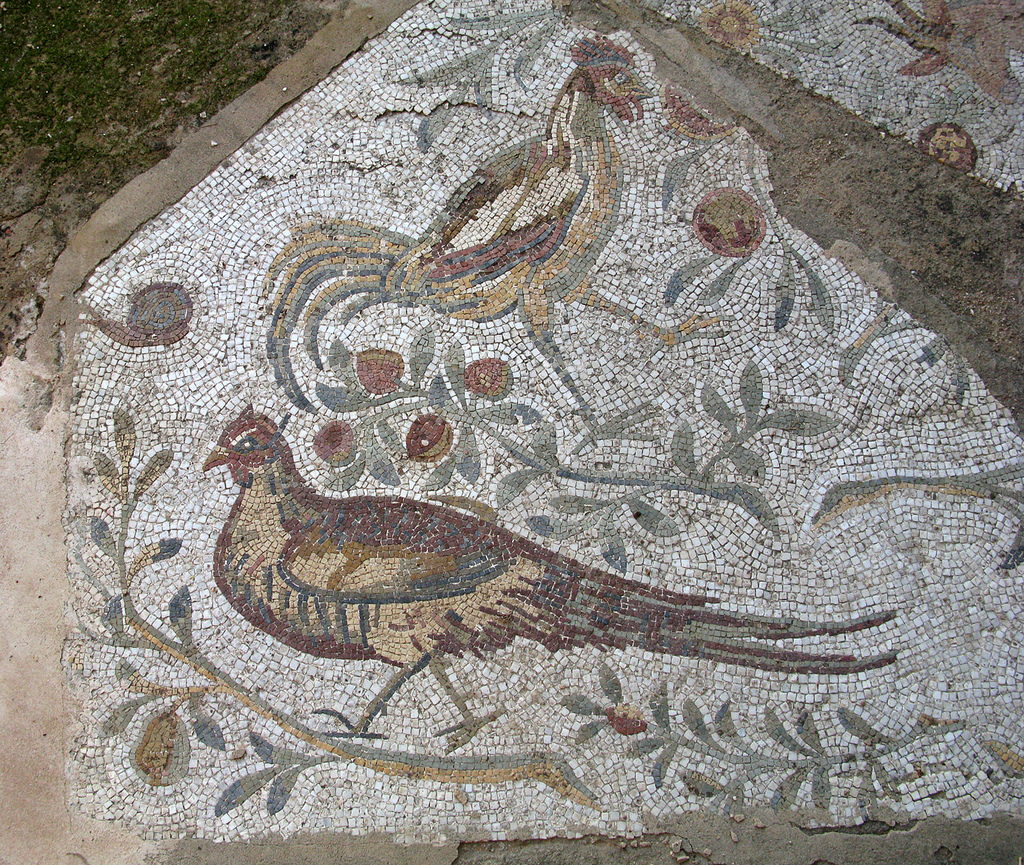| |
After completing our tour of the Bardo Museum, we still had an afternoon left, so we set off to visit the ruins of Carthage. Carthage is, in fact, still inhabited. We go there every Sunday to visit our friends who work at the embassy. It is now a posh suburb of Tunis, resplendent with nice villas and palm trees. But back in the day, it was the domain of Dido (who is called Elissa here, and appears on coins and bills, cell phone commercials, and anywhere else an imperiously beautiful woman is needed). Because the Romans sacked and took possession of the city at the conclusion of the third Punic War, most of the sites now are Roman. But there are a few remnants of the Carthage settled by the Phoenicians. Our first stop was the chilling site of Tophet, which the Romans claim was where the Punic Carthaginians practiced child sacrifice on a truly awful scale. Modern archaeologists dispute the claim, but our self-appointed guide was pleased to reiterate it repeatedly. He gleefully pointed out several carved stone instances of the symbol for the Babylonian deity Baal Hammon, composed of the Egyptian symbols for life, death, and eternity. I'd certainly prefer to believe that the Carthaginians just had a special cemetery for their beloved children who died young.
When we'd had enough of Tophet, we moved on to the Punic port, home of the fleet that made Carthage the ruling power of the Mediterranean for hundreds of years. It's now a small, sleepy island covered in wildflowers, but you can still see some of the dry docks that held ships when they were not in use.
Having dispensed with Punic Carthage, we were ready to take in its Roman splendor. So we set off for Byrsa Hill, the highest point in Carthage, and now mostly covered in lush modern villas. After wandering around lost among said villas for some time, we finally made it around the back of the hill and wound up to the very top, where dramatically excavated portions of Carthage are laid open to the air. In among the ruins of the Roman city is a quarter of the Punic city that somehow escaped the Roman razing, and shows what a row of Punic shops looked like in the age of Hannibal.
The attached museum contained some real treasures, like a gigantic head of a relative of Marcus Aurelius, an ancient baby bottle in the shape of a duck, and of course some more mosaics.
Our next stop was the truly colossal Antonine bath complex. Lonely Planet informed us that it had once included a large seaside swimming pool, as well as areas for wrestling and other typical Roman sports. More than a bath, it was a huge gym complex, another testament to the prosperity and consequent leisure time enjoyed by Roman Carthaginians.
By this time, Tony and I were quite exhausted, but the children were running ahead through the ruins with their usual exuberance. We dragged ourselves back to the car and drove to our last stop but one, the Roman Villas. It is incredible to me that there is so much left of them. Although everything is overgrown with a profusion of grass and wildflowers, I could really almost picture what it would have been like to have been a wealthy Roman living in long ago Carthage. And mosaic addict that I am, I was dazzled to find some intact mosaics adorning the re-planted garden of one of these ancient villas. Somehow, seeing them in their native habitat rather than up on the wall of a museum made these crumbling mosaics seem even more beautiful to me.
Exhaustion forgotten, I could have spent hours more at the Roman Villas. But we only had ten minutes left to make it to the Roman theater before it closed. Luckily, it was just around the corner. In fact, we had tried to pop in to the theater months ago, when we first came to visit our friends in Carthage. Since it was only a week or two after the revolution at the time, everything was closed. A decrepit and unofficial person at the gate offered to take us in and show us around anyway, but we had declined. This time, we screeched up with three minutes to spare, and then promptly plopped ourselves down, panting, in some unoccupied seats (actually, the entire theater was unoccupied). We were soon treated to an impromptu show performed by Axa and Dominique, which featured a medley of scenes taken from the Chronicles of Narnia and Star Wars, suitably dramatized for performance in a classical theater.
|
|

Carthage |

cemetery |

Punic port |

Bysra Hill |

Antonine bath complex |

|

|

|

Roman Villas |

|

|
|